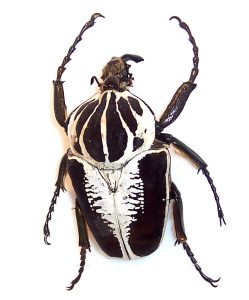Goliathus
“Goliath beetles are among the largest insects on Earth“
Domain: Eukaryota
Kingdom: Animalia
Phylum: Arthropoda
Class: Insecta
Order: Coleoptera
Family: Scarabaeidae
Subfamily: Cetoniinae
Tribe: Goliathini
Subtribe: Goliathina
Genus: Goliathus
Goliath beetles, named after the biblical giant Goliath, are a group of five species in the genus Goliathus. These beetles are among the largest insects on Earth in terms of size, bulk, and weight. They belong to the subfamily Cetoniinae within the family Scarabaeidae.
Goliath beetles thrive in many of Africa’s tropical forests, where they primarily feed on tree sap and fruit. Although little is known about their larval stage in the wild, they have been successfully raised from egg to adult in captivity with protein-rich foods like commercial cat and dog food.

Adult male Goliath beetles measure between 60 to 110 millimeters (2.4 to 4.3 inches), while females range from 50 to 80 millimeters (2.0 to 3.1 inches). In the larval stage, they can weigh up to 80 to 100 grams (2.8 to 3.5 ounces), though adults are only about half this weight. Females vary in color from dark chestnut brown to silky white, while males typically exhibit a brown, white, and black or black and white coloration.
Species
- Goliathus albosignatus Boheman, 1857
- Goliathus cacicus (Olivier, 1789)
- Goliathus goliatus (Linnaeus, 1771)
- Goliathus kolbei (Kraatz, 1895)
- Goliathus orientalis Moser, 1909
- Goliathus regius Klug, 1835
Life Cycle
Goliathus larvae are somewhat unusual among cetoniine scarabs due to their higher need for protein-rich foods compared to most other genera. In captivity, they thrive on a diet of dry or soft dog or cat food pellets, which should be regularly buried in their rearing substrate. Despite this need for protein, they still require a substrate of somewhat moistened, decayed leaves and wood to create a suitable environment for growth. The young larvae, in their first instar stage, will consume some of this decayed material. Due to their large size, it takes several months for the larvae to fully mature, eventually growing up to 250 millimeters (9.8 inches) in length and exceeding 100 grams (3.5 ounces) in weight.
Once the larvae reach maximum size, they construct a thin-walled, hardened cell from sandy soil for pupation. Within this cocoon, they undergo a transformation phase where their tissues are reorganized into the adult form. After metamorphosis is complete, the beetle sheds its pupal skin and enters a hibernation period as an adult until the dry season ends. When the rains return, the beetle breaks out of its cocoon, finds a mate, and the life cycle begins anew.
As adults, Goliathus beetles feed on sugary substances, particularly tree sap and fruit. In captivity, adult beetles can sometimes live for about a year after emerging from their pupal cells. However, their lifespan in the wild is likely shorter due to predators and environmental factors. The primary focus of the adult stage is reproduction, and once this is achieved, their time is limited, similar to many other insect species.
Description
Goliath beetles are known for their bulky bodies, which are protected by a thick and hardened exoskeleton. This exoskeleton shields their internal organs and hindwings. Like most beetles, Goliath beetles have reinforced forewings, called elytra, that serve as protective covers for their hindwings and abdomen. The hindwings, which are large and membranous, are used for flying and are kept completely folded under the elytra when not in use. Each leg ends in a pair of sharp claws, allowing the beetles to grip strongly while climbing tree trunks and branches.
Male Goliath beetles have a distinctive Y-shaped horn on their heads, which they use to fight other males for feeding sites or mates. Females lack these horns and instead have wedge-shaped heads that help them burrow when laying eggs. Besides their impressive size, Goliath beetles are also notable for their striking patterns. All Goliathus species have sharply contrasting black vertical stripes on the pronotum (thoracic shield). Each species can be further distinguished by their unique mix of elytral colors and patterns.
Conclusion
Goliathus beetles, with their massive size and striking patterns, are among the largest and most fascinating insects on Earth. Their robust bodies and unique adaptations, such as the Y-shaped horn in males and wedge-shaped heads in females, highlight their specialized roles and behaviors in their natural habitats. These beetles thrive in Africa’s tropical forests, where they play crucial roles in their ecosystems. Their life cycle, from protein-dependent larvae to impressive adults, reflects their complex and captivating biology, making them a subject of interest for both entomologists and nature enthusiasts.
Reference: